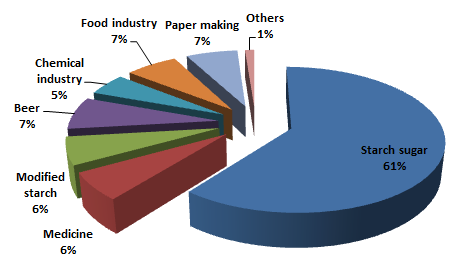Starch & Starch Derivatives Exhibition: Overview of China’s starch industry
Publish time:6/13/2017 12:00:00 AM Source: CCM
Information collection and data processing: CCM For more information, please contact us
On June 20 to 22, Shanghai will host the China International Starch and Starch Derivatives Exhibition. This event, which takes place annually, is the only professional starch trade fair in Asia. The exhibition in 2017 will be the twelve time of Shanghai welcoming experts and professionals from all over the world in the starch industry to grab their chances in China’s fast-growing starch market.

The profile of China’s starch event will cover the segments of starch, modified starch, starch sugar, fermentation products, starch derivates, and raw materials for starch. Furthermore, the 2017 Global Starch Industry Conference is going to take place as part of the event, which will focus on the latest applications of starch and bio-based materials. After all, bio-based materials are a worldwide focus of new materials, as well as an important field of China's strategic emerging materials industry and biomass industry. Developing environmentally-friendly and recyclable bio-based materials with rich biological resources is of great significance to replacing fossil resources, developing the cyclic economy, and building a resource-conserving and environmentally friendly society.
Market intelligence firm CCM gives an overview of the starch industry in China to prepare attendees for the game-changing event in Shanghai. Make an appointment with Kcomber, the parent company of CCM, at the exhibition by contacting econtact@cnchemicals.com.
Downstream sectors of the starch industry by consumption of starch in China, Jan.-Nov. 2016

Source: China Starch Industry Association
China’s corn starch demand normally remains weak in the period of March to September and starts to meet a peak period in October. Therefore, it is predicted that corn starch price is less likely to rise significantly in the coming period, due to the weak demand.
Notably, the corn starch industry has been suffered from oversupply for a long time. Corn starch output is likely to reach about 24.50 million tonnes in 2017, while the demand might settle around 23.50 million tonnes. Furthermore, the growth of output will even exceed the one of demand.
Besides, corn starch still actively expanded production capacity. In 2017, many corn deep processing companies increased capacity, with a combined rise of 10.70 million t/a, about 7.50 million tonnes of corn starch, according to the CSIA. Nevertheless, constructing production lines in a short time means short processing lines, which will result in structural overcapacity, a high degree of similarity and low added value of products. CCM predicts that the corn starch industry will still see overcapacity for a long time, especially with the government's subsidy policy.
In general, corn starch price fluctuates with the corn price. However, although corn price continued rising in May in China, the corn starch price declined. According to CCM's price monitoring, as of 13 May, the ex-works price of corn starch amounted to USD298.60/t
SG
China's SG industry has faced significant integration in recent years. For example, several domestic producers have expanded their capacities to seize larger market shares and others have completely stopped their production because of the environmental issue and fierce competition in the market. However, with the entrances and exits of some players, the major producers of SG in China remain concentrated in Shandong Province.
The output of SG in China kept increasing in the past 5 years due to the positive demand domestically as well as overseas. The prices of corn and corn starch kept decreasing from 2015 to 2016, which benefited the corn processing industry as well. In 2016, the output of SG in China reached 629,000 tonnes with a CAGR of 7.59% from 2012 to 2016.
The export of China's SG has been a rapid growth during 2012–2016. Stimulated by overcapacity and fierce competition in the domestic market, China's SG producers have paid more attention to the expansion of the overseas market, while the low-price level of SG also beneficial for their business expansion. Asia is still the major export destination of China's SG.
Concrete additive, water quality steadying agent, food and electroplating detergent are the major downstream products of SG in China. SG is mostly used in industrial fields. Nearly 90% of SG is consumed in concrete additive. Benefited from the increasing investment in infrastructure and real estate, the output of commodity concrete in China increased year by year, creating a greater demand for SG from 2012 to 2016.
In China, dairy products, as well as sauces, are the top end use application fields of modified food starch, accounting for about three-quarters of the total modified food starch sales volume by manufacturing giant Ingredion, in 2014 and 2015.
To be more precise, dairy products used about 41,500 tonnes of modified food starch in China in 2015, taking up 7.43% of the national total consumption. Dairy products using modified food starch include yoghurt, milk beverage, and cheese. Because of competition from overseas market, the output growth of China's dairy products has been quite slow during 2013~2015 with a CAGR of only 1%. The output in 2014 even dropped slightly over that in 2013.
The largest consumption field of modified food starch in China have been noodles, accounting for more than 38% of the consumption in 2015. Following have been meat products with around 14% and candy with almost 11% of share. Other notable consumption fields have been snack food, frozen food, dairy, and seasoning paste.
Starch sugar
The past two years has seen declining profits for China's starch sugar industry. Firstly, competition among starch sugar enterprises was fierce, and secondly, it is difficult to either market high value-added products or earn profits, as prices of raw materials are low. To sum up, the starch sugar industry in China is barely profitable now.
The number of starch sugar enterprises in China has fallen from over 120 to only 107. Of the remaining enterprises. Moreover, industrial integration has taken place in China's starch industry, contributing to the development of the market and increasing industry concentration. That is to say, medium- and small-sized starch sugar producers are gradually being replaced by large-sized ones; outmoded capacity and enterprises which pollute the environment are to be gradually eliminated.
Starch sugar is mainly used in the food industry, especially in the beverage and pastry industries. Given that the cane sugar price remains high and the starch sugar price is low at present, replacing cane sugar with starch sugar seems the more sensible choice. However, according to CCM's research, as of the end of March, the sales/production ratio for sugar was 43.2%, vs. 40.3% in the same period in 2015/16, which indicates that demand for starch sugar might be sluggish in the future.
Recently, researchers were substituting corn starch sugar for sugar to make ice cream. In the last 6 months, the purchase price of sugar increased from USD738.18/t to near USD1,033.45/t. In the meantime, the price of starch sugar declined from USD354.32/t to USD295.27/t, due to the falling corn price. However, the sweetness of starch sugar is not as high as sugar. The related person also revealed that the cost of sugar takes up a large part of ice cream production costs, and using starch sugar to replace sugar can reduce 35% of production costs.
About CCM
CCM is the leading market intelligence provider for China’s agriculture, chemicals, food & ingredients and life science markets.
Do you want to find out more about the starch market in China? Try our Newsletters and Industrial Reports or join our professional online platform today and get insights in Reports, Newsletter, and Market Data at one place.
For more trade information of starch products, including Import and Export analysis as well as Manufacturer to Buyer Tracking, contact our experts in trade analysis to get your answers today.
Meet Kcomber at the exhibition on June 20 – 22. Please contact mailto:econtact@tranalysis.com.com for making an appointment.